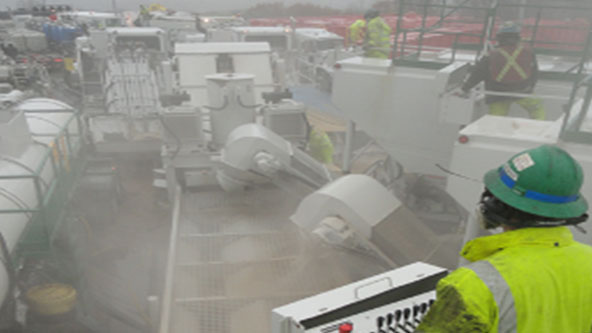Working Safely with Crystalline Silica
Posted on December 18, 2013 | in Safety

Safety & Care When Working with Crystalline Silica
Crystalline Silica is a mineral found in the Earth’s crust and comes in several forms, most commonly in quartz; the other two forms are cristobalite and tridymite. It is so widely used in various industries that people come into contact with it literally every day. Used in everything from glass to paint to metallurgy, crystalline silica is an extremely important for industrial use. Without crystalline silica, items like glass, mortar and basic building and infrastructure materials could not be created and used. But it does have its hazards, and it is important to follow OSHA guidelines when handling it.
Handling Crystalline Silica
Proper handling of crystalline silica dust is extremely important. Handling crystalline silica in large form is not hazardous; it’s when it is ground or drilled that crystalline silica creates a serious hazard to workers in the form of crystalline silica dust. As such, OSHA has established what is known as a Permissible Exposure Limit for it, or PEL. The PEL determines the specific maximum amount of crystalline silica that workers can be exposed to during any eight-hour work shift (29 CFR 1926.55, 1910.1000). In addition, OSHA also requires employers to provide hazard communication training for workers who will be exposed to crystalline silica as well as a respirator protection program until engineering controls are implemented. Other recommended OSHA suggestions are:
- Use safer substitutes when possible
- Use proper protective equipment and provide ventilation and designated blasting areas
- Control dust exposures as much as possible
- Wear only a N95 NIOSH certified respirator and ensure that a good seal is between the respirator and the face, regardless of facial hair
- Wear only a Type CE abrasive-blast supplied-air respirator for abrasive blasting
- Wear clothes that are either disposable or washable to help eliminate the dust
- Do not make your lungs even more susceptible to crystalline dust by smoking
- Do not eat, drink, smoke, or apply cosmetics in areas where crystalline silica dust is present and wash your hands and face frequently prior to doing any of these activities
Health Risks Associated with Crystalline Silica
Crystalline silica isn’t just dust. Proper precautions and good industrial hygiene practices must be followed to ensure a safe working environment by reducing environmental concentrations to the permissible exposure level for your employees. It must be remembered that crystalline silica is a classified carcinogen. When crystalline silica dust is inhaled over a long period of time, workers can develop a progressive, irreversible and potentially deadly illness called Silicosis.
Silicosis
Silicosis is a form of occupational lung disease caused by inhalation of crystalline silica dust, and is marked by inflammation and scarring in the form of nodular lesions in the upper lobes of the lungs. It is a type of pneumoconiosis. When the dust is inhaled, it causes scar tissue to develop within the lungs, reducing the person’s ability to breath in oxygen. This scar tissue also makes the person more susceptible to lung infections.
To date, there are three types of silicosis:
- Chronic and/or classic silicosis
- Accelerated silicosis
- Acute silicosis
Each classification is marked by severe respiratory problems that are progressive and invasive. Death can result from any of the three. For more information on crystalline silica and other hazardous chemicals, contact us.